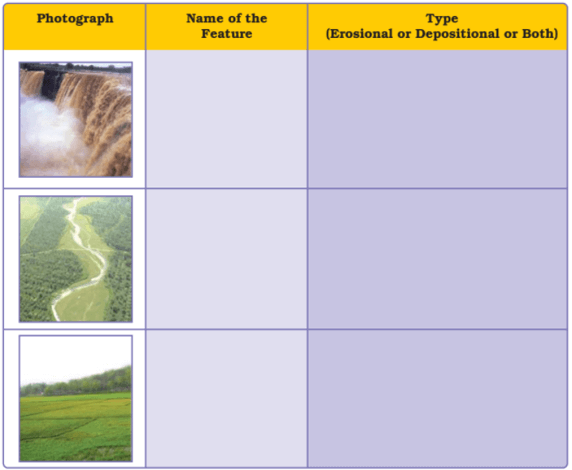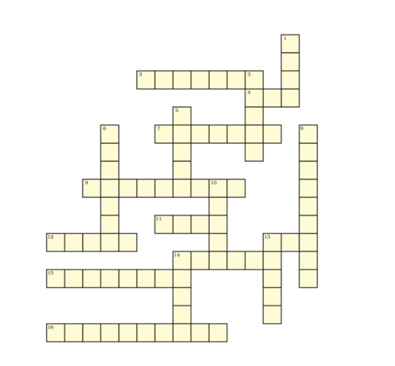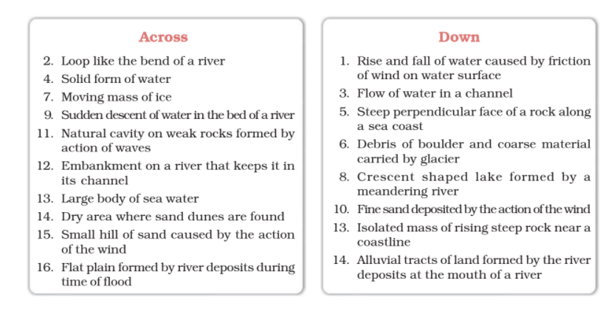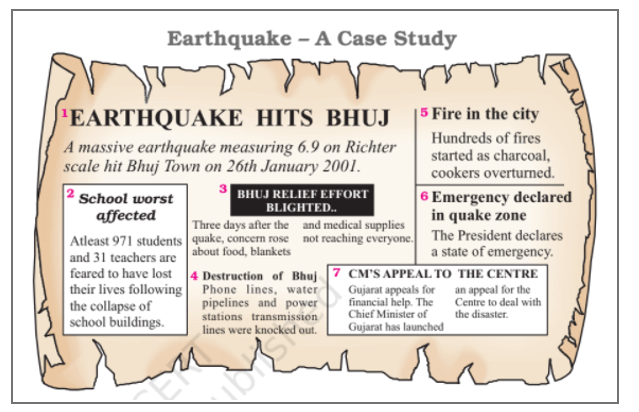Geography - Class 7
Our Environment
Chapter 3: Our Changing Earth
Question 1:Answer the following questions.
(i) Why do the plates move?
Answer:The lithospheric plates move because of the movement of the molten magma inside the earth. The molten magma inside the earth moves in a circular manner.
(ii) What are exogenic and endogenic forces?
Answer:The forces which act in the interior of the earth are called as Endogenic forces and the forces that work on the surface of the earth are called Exogenic forces.
(iii) What is erosion?
Answer:Erosion is the wearing away of the landscape by different agents like water, wind, and ice.
(iv) How are flood plains formed?
During floods, layers of fine soil and other material called sediments are deposited along its bank. This leads to the formation of a flat fertile floodplain.
(v) What are sand dunes?
Answer:When the wind blows, it takes the sand from one place to another. When it stops blowing, the sand falls and gets deposited in low hill-like structures, these are called sand dunes.
(vi) How are beaches formed?
Answer:The beaches are formed when the sea waves deposit sediments along the seashores.
(vii) What are ox bow lakes?
Answer:As the river enters the plain it twists and turns to form large bends known as meanders. Due to continuous erosion and deposition, the ends of the meander loop come closer. In due course of time, the meander loop cuts off from the river and forms a cut-off lake which is called an ox-bow lake.
Question 2:Tick the correct answer.
(i) Which is not an erosional feature of sea waves?
(a) Cliff
(b) Beach
(c) Sea cave
(ii) The depositional feature of a glacier is:
(a) Flood plain
(b) Beach
(c) Moraine
(iii) Which is caused by the sudden movements of the earth?
(a) Volcano
(b) Folding
(c) Flood plain
(iv) Mushroom rocks are found in:
(a) Deserts
(b) River valleys
(c) Glaciers
(v) Ox bow lakes are found in:
(a) Glaciers
(b) River valleys
(c) Deserts
Answer:
(i). (b) Beach
(ii). (c) Moraine
(iii). (a) Volcano
(iv). (a) Deserts
(v). (b) River valleys
Question 3:Match the following.
| (i) Glacier | (a) Sea shore |
| (ii) Meanders | (b) Mushroom rock |
| (iii) Beach | (c) River of ice |
| (iv) Sand dunes | (d) Rivers |
| (v) Waterfall | (e) Vibrations of earth |
| (vi) Earthquak | (f) Sea cliff |
| (g) Hard bed rock | |
| (h) Deserts |
Answer:
| (i) Glacier | (c) River of ice |
| (ii) Meanders | (d) Rivers |
| (iii) Beach | (a) Sea shore |
| (iv) Sand dunes | (h) Deserts |
| (v) Waterfall | (g) Hard bed rock |
| (vi) Earthquake | (e) Vibrations of earth |
Question 4:Give reasons.
(i) Some rocks have a shape of a mushroom.
Answer:In deserts, we can see rocks in the shape of a mushroom, commonly called mushroom rocks. When the wind blows, it lifts and transports sand from one place to another. Winds erode the lower section of the rock more than the upper part. Therefore, such rocks have narrow waves and wider tops.
(ii) Flood plains are very fertile.
Answer:When the river overflows through its banks, this leads to the flooding of the neighboring areas. As it floods, it deposits layers of fine soil and other material called sediments along its banks. This lead to the formation of a flat fertile floodplain.
(iii) Sea caves are turned into stacks.
Answer:The erosion and deposition of the sea waves result in coastal landforms. Sea waves continuously strike and the rocks, due to which cracks are developed. Over time they become larger and wider. Thus hollow-like caves are formed on the rocks. they are called sea caves. As these cavities become bigger and when only the roof of the caves remain, it forms sea arches. Then erosion breaks the roof and only walls are left these walls are called stacks.
(iv) Buildings collapse due to earthquakes.
Answer:When the lithospheric plates move the surface of the earth vibrates. These vibrations are called earthquakes. The vibration can travel all around the earth. An earthquake can cause great destruction. Buildings collapse due to earthquakes. The earthquakes cannot be predicted but we can minimize their impact by preparing beforehand.
Question 5:Activity.
Observe the photographs given below. These are various features made by a river. Identify them and also tell whether they are erosional or depositional or landforms formed by both.

Answer:
Photograph 1 : Waterfall- Erosional and depositional both
Photograph 2 : meander- Erosional and depositional both
Photograph 3 :Floodplain- depositional
Question 6:For fun.
Solve the crossword puzzle with the help of given clues.


Answer:
- Wave
- Meander
- River
- Ice
- Cliff
- Moraine
- Glacier
Intext Questions:
Question :Find out the names of the few rivers of the world that form a delta.
Answer:
- Amazon Delta.
- Danube Delta.
- Ganges–Brahmaputra Delta.
- Godavari Delta.
- Indus River Delta.
Activity:

- Read the ‘Earthquake – A case study’ given in the form of headlines that appeared in the newspapers after the quake. Arrange the events in the right sequence of their happening.
- Imagine if a quake suddenly shook in the middle of the school day, where would you go for safety?
Answer 1:
- Earthquake hits Bhuj: A massive earthquake measuring 6.9 on Richter scale hit Bhuj Town on 26th Jan. 2001.
- Fire in the city: Hundreds of fire started as charcoal, cooker overturned.
- Destruction of Bhuj: Phone lines,water pipelines and power stations, transmission lines were knocked out.
- School worst affected: Almost 971 students and 31 teachers are feared to have lost their lives following the collapse of school buildings.
- Emergency declared in quake zone: The President declares a state of emergency.
- CM’s appeal to the Centre: Gujarat appeals for financial help. The chief minister of the Gujarat has launched an appeal for the center to deal with the disaster
- Bhuj relief effort blighted: three days after the quake, concern rose about food, blankets, and medical supplies not reaching everyone.
Answer 2:
- Drop to your knees and hands.
- Get under your desk and cover your head and neck with your arms.
- Stay away from glass, windows, and heavy bookcases.
- Don’t rush to the exit.
- If outside, stay away from trees, buildings, and power lines.
- Remember to remain quiet when assembling outside.
- Listen carefully to adults for directions.